Kyoto Neighborhoods, Locations and Districts
(Kyoto, Kansai, Central Honshu, Japan)
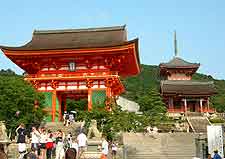
Visitors to Kyoto are indeed spoilt for choice when it comes to sightseeing and finding a place to stay. As most tourists arrive via train at Kyoto Station, in central Kyoto, this can be a convenient area to make a base, with the districts and locations around both the Imperial Palace and Nijo Castle offering plenty of hotels.
The eastern half of the city has dozens of temples and shrines worth visiting, but the main attraction here is Gion, where thousands flock to catch even a brief glimpse of a real-life geisha. Kyoto's main districts and neighbourhoods are shown below.
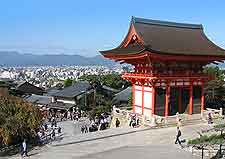
Eastern Kyoto District
Aside from the city's most famous district of Gion, the eastern area of the city contains several prominent temples, such as Kiyomizudera, famous for its large terrace; Kodaiji, built as a memorial to Toyotomi Hideyoshi; Chionin, the leading temple for the Jodo sect of Buddhism; and Nanzenji, a Zen temple boasting a stunning rock garden. Other attractions within the Eastern Kyoto district include the path of Philosophy, a walking trail that is breathtakingly beautiful during the cherry blossom season.
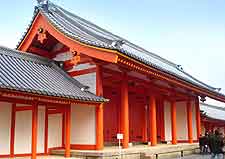
Central Kyoto District
Central Kyoto is where the emperor's former residence up until 1868, the Imperial Palace, is located. Other attractions in this lively district include Nijo Castle, the home of the Togugawa Shogun, and Nijo Jinya, formerly used to lodge visiting feudal lords. Japan's tallest pagoda, Toji, is centrally located and one of the city's must-sees. Visitors looking to enjoy some lively nightlife should head to the Pontocho area, where there is a good selection of entertainment. The futuristic Kyoto Station makes accessing the central parts of the city easy. There are also several prominent hotels situated close to Nijo Castle and Kyoto Station.
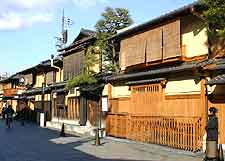
Gion District
Located in the eastern section of Kyoto, this is the most famous of the geisha districts and many tourists visit Gion to catch a glimpse of these white-faced and beautifully dressed entertainers. Sited to the east of Kamo River, the Gion district of Kyoto consists of many plain wooden buildings, where thousands of geisha once lived. Now home to a mere couple hundred of these kimono-clad ladies, visitors can catch glimpses of geisha as they walk past the teahouses and restaurants around this district. The geisha houses themselves are very difficult to gain access to, with private invitations necessary. Visitors can also enjoy the Yakasa Shrine whilst geisha-spotting in Gion.
Nishijin District
Also known as the Weaving district, the Nishijin area is well preserved with entire streets lined with 100-year-old wooden buildings. The architecture is the primary attraction here, with many of the buildings having been constructed without the use of nails.
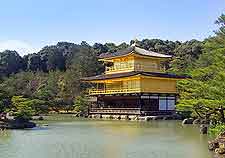
Northern Kyoto District
Like other parts of the city, Kyoto has its fair share of prominent shrines and temples, with the most significant being Kinkakuji (Golden Pavilion), Ryoanji, Ninnaji, Daitokuji and Enryakuji. Aside from religious sites, other attractions in the northern section of the city include both the Toei Eigamura theme park and the hot springs at Kurama.
Western Kyoto District
Katsura Villa is the main attraction in the Western Kyoto district, being one of the most outstandingly beautiful imperial villas in all of Japan. Other sightseeing options include the Tenryuji Temple and Arashiyama, famous for its bridge, park, mountain and boat tours down the Honzu River. There are a few hotel choices in Arashiyama, which is accessible by train.
 Visitors to Kyoto are indeed spoilt for choice when it comes to sightseeing and finding a place to stay. As most tourists arrive via train at Kyoto Station, in central Kyoto, this can be a convenient area to make a base, with the districts and locations around both the Imperial Palace and Nijo Castle offering plenty of hotels.
Visitors to Kyoto are indeed spoilt for choice when it comes to sightseeing and finding a place to stay. As most tourists arrive via train at Kyoto Station, in central Kyoto, this can be a convenient area to make a base, with the districts and locations around both the Imperial Palace and Nijo Castle offering plenty of hotels.


